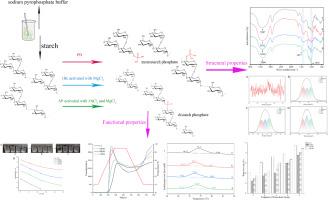Structural and physicochemical properties of corn starch modified by phosphorylase b, hexokinase and alkaline phosphatase
IF 10.7
1区 化学
Q1 CHEMISTRY, APPLIED
引用次数: 0
Abstract
To improve the functional properties of corn starch, phosphorylase b (PB), hexokinase (HK), and alkaline phosphatase (AP) were used to produce enzyme-modified starches (PBMS, HKMS, and APMS). The results showed that enzyme-modified starches had different phosphorus contents and degrees of substitution. The presence of P![]() O bonds and P-O-C bonds further demonstrated that phosphate groups were grafted into starch. The proportions of monostarch phosphate in PBMS, HKMS, and APMS were 77.05 %, 79.33 % and 85.88 %, respectively. The introduction of phosphate groups affected the functional properties of starch. The swelling powers of PBMS, HKMS and APMS increased from 0.99 % to 12.86 %, 10.83 % and 5.95 %, respectively. Compared to native starch (1820 mPa·s), the peak viscosities of PBMS, HKMS and APMS increased to 2655, 2838, and 2021 mPa·s, respectively. Meanwhile, the introduction of phosphate groups endowed phosphorylated starch with better freeze-thaw stability, larger paste transparency, higher solubility, and slower retrogradation rate.
O bonds and P-O-C bonds further demonstrated that phosphate groups were grafted into starch. The proportions of monostarch phosphate in PBMS, HKMS, and APMS were 77.05 %, 79.33 % and 85.88 %, respectively. The introduction of phosphate groups affected the functional properties of starch. The swelling powers of PBMS, HKMS and APMS increased from 0.99 % to 12.86 %, 10.83 % and 5.95 %, respectively. Compared to native starch (1820 mPa·s), the peak viscosities of PBMS, HKMS and APMS increased to 2655, 2838, and 2021 mPa·s, respectively. Meanwhile, the introduction of phosphate groups endowed phosphorylated starch with better freeze-thaw stability, larger paste transparency, higher solubility, and slower retrogradation rate.

经磷酸化酶 b、己糖激酶和碱性磷酸酶改性的玉米淀粉的结构和理化特性
为了改善玉米淀粉的功能特性,使用磷酸化酶 b(PB)、己糖激酶(HK)和碱性磷酸酶(AP)来生产酶改性淀粉(PBMS、HKMS 和 APMS)。结果表明,酶改性淀粉具有不同的磷含量和取代度。PO 键和 P-O-C 键的存在进一步证明磷酸基团已接枝到淀粉中。单淀粉磷酸在 PBMS、HKMS 和 APMS 中的比例分别为 77.05%、79.33% 和 85.88%。磷酸基团的引入影响了淀粉的功能特性。PBMS、HKMS 和 APMS 的膨胀率分别从 0.99 % 增加到 12.86 %、10.83 % 和 5.95 %。与原生淀粉(1820 mPa-s)相比,PBMS、HKMS 和 APMS 的峰值粘度分别增加到 2655、2838 和 2021 mPa-s。同时,磷酸基团的引入使磷酸化淀粉具有更好的冻融稳定性、更大的糊状透明度、更高的可溶性和更慢的逆降解速率。
本文章由计算机程序翻译,如有差异,请以英文原文为准。
求助全文
约1分钟内获得全文
求助全文
来源期刊

Carbohydrate Polymers
化学-高分子科学
CiteScore
22.40
自引率
8.00%
发文量
1286
审稿时长
47 days
期刊介绍:
Carbohydrate Polymers stands as a prominent journal in the glycoscience field, dedicated to exploring and harnessing the potential of polysaccharides with applications spanning bioenergy, bioplastics, biomaterials, biorefining, chemistry, drug delivery, food, health, nanotechnology, packaging, paper, pharmaceuticals, medicine, oil recovery, textiles, tissue engineering, wood, and various aspects of glycoscience.
The journal emphasizes the central role of well-characterized carbohydrate polymers, highlighting their significance as the primary focus rather than a peripheral topic. Each paper must prominently feature at least one named carbohydrate polymer, evident in both citation and title, with a commitment to innovative research that advances scientific knowledge.
 求助内容:
求助内容: 应助结果提醒方式:
应助结果提醒方式:


